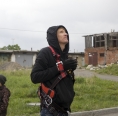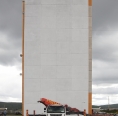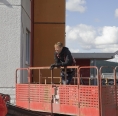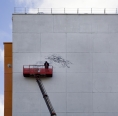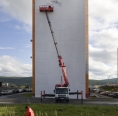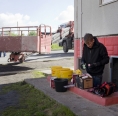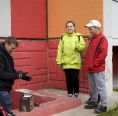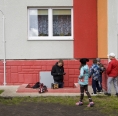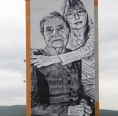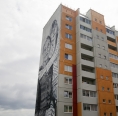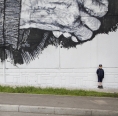-
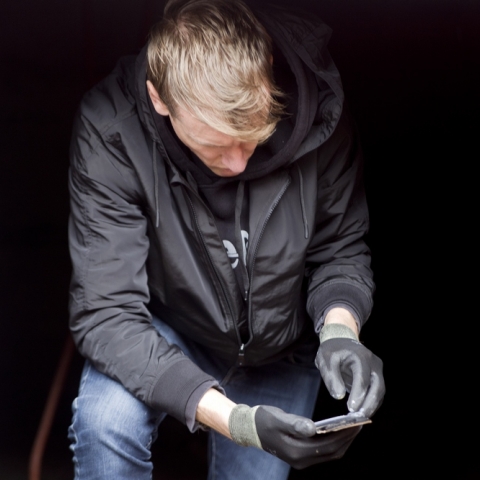
Bright Emotions
-
Address:
-
Partners:
Artist from Germany Hendrik Beikirch, a participant of the second International Street Art Festival “Satka Street Art Fest,” finishes painting facade of house No. 23 on Metallurgov Street in Satka. Now this building is decorated with unusual street art work – huge, but very touching and kind portrait of great-grandmother and great-granddaughter.
Recently, Hendrik has met with Satka mass media and told about his work, about how he chose the characters for the portrait, and shared his impressions and art plans.
For the First Time in Satka
- Mister Beikirch, please tell us how you learned about our town before you came and started working?
- I always say that this is joint work of the team. And I am very grateful to the providers of the Satka Street Art Fest festival for great preparatory work made before my arrival. We discussed and prepared for this project for almost year. One thing is when artist just comes to town, and another thing – when such projects are created. When I came, everything was agreed and settled, as to the house, to the characters, all necessary materials were bought, the wall was prepared for painting. And this is a very large amount of work.
- How did you look for characters of the future portrait?
- In this case, it was kind of magic. I believe in magic things: sometimes you find photo, and sometimes they find you.
When festival providers offered me to make sketch with collective image of Satka residents, I said that I can come to Satka to walk by streets, to look at people, to make drafts... But it would take quite a lot of time, and since I have a very busy schedule, I was offered to select some photo portraits. Of more than 40 photos of elderly people who were selected at the editorial office of newspaper Magnezit News, I chose two portraits – a grandfather with his grandson and a great-grandmother with her great-granddaughter. And offered the providers to take part in selection of the characters, but they left the choice for me.
- Why did you choose female images? And why do you end up drawing double portrait? Earlier, you depicted only single characters, and mostly men...
- When I saw this photo, I realized that the female characters cannot be divided and even presented separately. One simply cannot exist without the other. Their faces emitted light. It were emotions. And for me, these feelings are very important, I believe my first feelings. If I am hooked at once, then I will succeed in it, I’m 99 percent confident of it. That was the case with our project. As a result, I actually for the first time paint double female portrait. And it has movement – a dialog between two generations.
Editorial note: Providers met with relatives of the characters of the unusual portrait beforehand, and received their consent to create the drawing with the great-grandmother and the great-granddaughter. Now we can already say that the persons on the portrait are Magnesite veteran, homefront worker Maria Perfilyevna Feklicheva (Magnezit News, No. 6 dated February 19, 2016) and her great-granddaughter Arina.
By the way, Arina, together with her mother Christina Aleksandrovna and grandmother Vera Nikolayevna, watched Hendrik’s work very closely, with great interest and excitement, and met the author.
- We really liked the author and his work, – says Vera Nikolayevna Gerasimenko. – We communicated via interpreter and had our photo taken together. Hendrik is a very interesting, emotional, friendly and very smiling, simple person. He is absolutely not a stranger, he’s like a relative.
We watched his work every day – this is a unique case. The offer to draw portrait of my mother and granddaughter was very unexpected and exciting. Unfortunately, my mother died two months ago. And at late May, we were told about this significant and important event for our whole family.
I did not even know how I will react, because the wound is still so fresh. But now, I can see the portrait even from my bedroom windows (we live on Industrialnaya Street), and every morning I greet my mother. Impressions are unforgettable and only positive, despite the arising difficulties: people react differently, unfortunately, we’ve also heard negative things. So, I would like to thank the providers and you for telling our story, explaining how such a portrait had appeared in our town. And I would express our gratitude to Hendrik for his amazing art!
Expressive Monochrome
- How did you come to your style? Why do you create large portraits in monochrome palette?
- Black and white drawings, old film portraits, they are more contrast, and therefore they show emotions better. Color can distract, and black and white image reflects everything more clearly.
- How do you transfer image from a small photo to such a large wall? Do you use projector, or is it a special technique, a professional secret?
- No, I do not use projector, I draw portrait in parts. The wall is made up of blocks. The most important thing is to find character that would be interesting to draw, but technically it’s easy if you can imagine all elements of the portrait in space. You should not be afraid of size, afraid of height and should understand how the drawing will look from a distance. Street art is an art created in public places. It, of course, differs from the art represented in closed spaces, in museums, for example.
- Is portrait surroundings important for you? Sounds, people, actions around the house, nature, general background?
- Certainly. Now, I work on an object which is a house where people live. By creating the drawing, I come into their space and surrounding territory. This is a special story. For example, in museums, we first see the object itself which is separated from reality, and nothing prevents its perception. And for me, communicating with children, with local residents is engaging in their history, and engaging them in my work. It’s an important, interesting and integral part of my creation of art. When people come to see an exhibition, they see only works. And here, they can observe how everything happens, from the start till the end.
- And how do local residents react to your art?
- From the first days, I felt that they like the painting creation process. Everything happens together – when adults come, when children surround the platform and wait for me to go down. They do not speak English, but it does not prevent us from communicating. They treat to sweets and ask questions all the time. Some have specially learned a few English words. Once they asked to sign on their palms. But festival providers made postcards with town views for them, each child told their name, and I signed them their postcards. Everyone is very happy with this live communication.
- Did you consider other drawing placement variants, other than the house on Metallurgov Street?
- Yes, it was an entire process. Initially, we discussed another house, but now I’m confident that the location chosen is ideal.
- The house itself is very bright, orange. How, in your opinion, will such color scheme affect emotional perception of the portrait?
- Black and white drawing will look more contrast against such background.
Each character is a special person and story
- Which of your previous works is most important for you, perhaps, it has a story behind the character that really impressed you?
- For me, each work is special. Because there is a certain story behind each of them, in which I completely immerse. But sometimes, it comes to me that I did some works better than others. But this is life: you can long for something, you can try to fight, to wish something, but you not always achieve 100 percent success. Then I believe that this happens for some reason, not for nothing.
- All your characters are mature people. Why do you choose such characters?
- This is my attitude to beauty. Because it’s ambiguous. What is important for me is not external, but inner beauty. And wrinkles for me are proof of life, they mean that the person lived, felt...
- Do you think that street art influences changes in surroundings? Does history of such works continue?
- I think that art always influences surroundings. If it does not bring out any emotions, if people do not care, it’s bad. But even if people do not like it, it is also an opinion and an occasion for discussion.
- Do you always work alone? Or do you have joint projects with colleagues?
- If wall was very large, I would use an assistant. Now, the wall that I draw on is not small, but I work fast enough, because I really enjoy the process. I do not always work alone. I had and plan joint projects with other artists, both works on facades, and joint exhibitions.
- What does your nickname ECB mean?
- In the street art culture, artists always have good-sounding names – nicknames. And when I was thinking of my own nickname, I decided that it would be more fun, romantic and interesting if it is just a set of letters not connected with anything. And everyone can think of it what they want. But in fact, it’s not a name, and not an abbreviation, there’s no sense in these letters. It’s kind of a game, a riddle.
Celestial Gravitation
- It’s not your first time in Russia, maybe you have some favorite places or objects where you want to implement new creative ideas?
- There are a lot of Russian visas in my passport, but I want to come back here many times. Satka is currently one of my favorite places in Russia. People here have very beautiful souls, and the sky here is amazing and really beautiful. I want to sit down and watch it. It constantly changes and fascinates.
- And yet, do you have an idea that you want to implement in Russia and maybe again in our town?
- Currently, I don’t have specific ideas, but I always have some thoughts that I want to implement in the future. I would like to live a little in Russia to implement some new ideas here.
- Did you have any funny cases in your practice?
- Earlier, when there were no mobile phones, it was tougher. For example, when the car (aerial elevating platform – ed. note) ran out of gas, you had to wait long, sitting in the basket, when you will be brought down.
- And what is important up on the wall? How do you start your work, how do you tune yourself, what do you listen to while you’re working – music, maybe, wind or the town?
- I do not do anything special. First, I drink coffee, but when I go up, I do not know if everything will go smoothly. I don’t really try to manage the process because I immerse in it, what is important to me are emotions and feelings.
- Do you follow the fate of your works, what happens to them after their completion?
- Yes, recently, I was in Korea and looked at how does my Elderly Fisher getting on. (The largest street art in Asia on a skyscraper in Busan, South Korea. August 2012 – ed. note). Sometimes I purposely come to the cities where I worked, sometimes I receive photos. When work is not in a gallery but on a street, it ages and can fade. But it’s not a loss, it’s its history, it’s a sign of life.
- What do you plan after Satka?
- I’ll go to New York (both on business and for pleasure), and then to Marrakech where I have a big exhibition soon.
- You travel a lot, what do you leave for yourself from your travels? What is precious for you?
- The most important thing is experience, impressions and memories.
Editorial note: We can only add that the International Street Art Festival “Satka Street Art Fest” is supported by the Sobranie Fund which implements social and cultural projects in Satka during several years. The festival providers are in constant search for new partners. This year, they received financial support from the Russian Presidential Grant Fund. Organizational support is provided by administration of the Satka Municipal District. One important moment is that neither preparation nor festival events involve use of budget funds not to mention funds of apartment houses owners. The providers pay all expenses connected with the preparation of future “canvases” – renovation of seams on buildings’ facades, priming wall surfaces, improvement of adjacent territory.
Source: Magnezite News
Anna Filippova, photo by Vasily Maksimov, Sergey Poteriaev.
-
26.08 - 26.08
DIARY OF THE THIRD INDUSTRIAL BIENNALE
-
28.11 - 28.11
MY SATKA FESTIVAL WINS THE CONTEST OF CORPORATE VOLUNTEER PROJECTS
-
13.10 - 15.10
COOPERATION WITH VGIBL NAMED AFTER M.I. RUDOMINO

